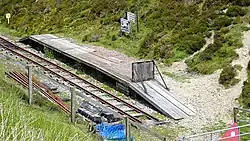Wanlockhead railway station
Wanlockhead railway station was opened on 1 October 1902[2] as the terminus on the Leadhills and Wanlockhead Light Railway and served the lead mining area, farms and the village of Wanlockhead. Elvanfoot railway station in South Lanarkshire was the junction for the branch and was located on the west coast main line. It remained open until 2 January 1939 for passengers and freight.[2] When Wanlockhead station opened in 1902, a year after Leadhills station, it became the highest standard gauge adhesion station in the United Kingdom at 1413 feet, seven miles and 24 chains from Elvanfoot.[6][7]
Leadhills and Wanlockhead Branch | ||||||||||||||||||||||||||||||||||||||||||
|---|---|---|---|---|---|---|---|---|---|---|---|---|---|---|---|---|---|---|---|---|---|---|---|---|---|---|---|---|---|---|---|---|---|---|---|---|---|---|---|---|---|---|
| ||||||||||||||||||||||||||||||||||||||||||
Wanlockhead | |
|---|---|
| Location | South Lanarkshire Scotland |
| Grid reference | NS 87419 12607 |
| Platforms | 1 |
| Other information | |
| Status | Disused |
| History | |
| Pre-grouping | Caledonian Railway |
| Post-grouping | London Midland and Scottish Railway |
| Key dates | |
| 19 September 1902 | Open to freight[1] |
| 1 October 1902 | Station opens to passengers[2] |
| 31 December 1938[3] | Last passenger train |
| 2 January 1939 | Line officially closed to passengers and goods[4][5] |
History
Operated by the Caledonian Railway, it became part of the London, Midland and Scottish Railway during the Grouping of 1923. The line had been closed and lifted before the Scottish Region of British Railways came into existence upon nationalisation in 1948.[5] The line suffered greatly from the closure of the lead mines and passenger traffic was slight, although the station was located near to the small village of Wanlockhead.
Infrastructure

To save on costs the passenger stations at Wanlockhead had only slightly raised platforms and therefore passenger carriages had three levels of step board fitted which folded down to enable passengers to board and depart.
The platform at Wanlockhead was demarcated by a wooden fence and a passing loop of 100 yards length was provided.[8] A siding served a loading bank and another the goods shed.[8] The waiting room, stationmaster's office, ticket office and men's toilet were located in a wooden lean-to building built along the long side of the goods shed.[9] No signals were present, however a telephone was provided.[9] The points were worked by ground frames in the absence of a signal box. In 1916 a new siding was installed at the north side of the line.[10]
The site today
The track had already been lifted by April 1939 and the buildings demolished.[3] The Leadhills and Wanlockhead Railway narrow gauge line and station are to be extended from Glengonnar Halt towards the site of the old station and its trackbed in the near future (datum 2019).[6]
| Preceding station | Historical railways | Following station | ||
|---|---|---|---|---|
| Leadhills | Caledonian Railway Leadhills and Wanlockhead Branch |
Terminus | ||
References
Notes
Sources
- Butt, R. V. J. (1995). The Directory of Railway Stations: details every public and private passenger station, halt, platform and stopping place, past and present (1st ed.). Sparkford: Patrick Stephens Ltd. ISBN 978-1-85260-508-7. OCLC 60251199.
- Ireland, Alastair (2011). The Leadhills and Wanlockhead Railway. Kelso : Alastair Ireland ISBN 0-9516271-1-2.
- Thomas, J. (1971). Scotland: the lowlands and borders. A regional history of the railways V.6. Newton Abbot.
- Wham, Alasdair (2017). Exploring Dumfries & Galloway's Lost Railway Heritage. A Walker's Guide. Catrine : Oakwood Press ISBN 9780853610830.
- Wignall, C.J. (1983). Complete British Railways Maps and Gazetteer From 1830-1981. Oxford : Oxford Publishing Co. ISBN 0-86093-162-5.